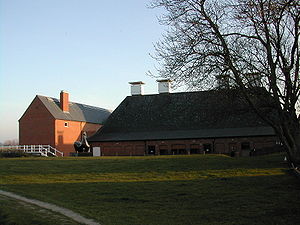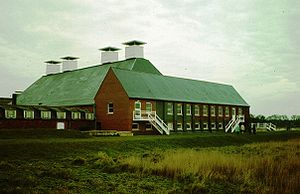
Snape Maltings
Encyclopedia


Snape, Suffolk
Snape is a small village in the English county of Suffolk, on the River Alde close to Aldeburgh. It has about 600 inhabitants. Snape is now best known for Snape Maltings, no longer in commercial use, but converted into a tourist centre together with a concert hall that hosts the major part of the...
, U.K.
United Kingdom
The United Kingdom of Great Britain and Northern IrelandIn the United Kingdom and Dependencies, other languages have been officially recognised as legitimate autochthonous languages under the European Charter for Regional or Minority Languages...
, best known for its concert hall, which is one of the main sites of the annual Aldeburgh Festival
Aldeburgh Festival
The Aldeburgh Festival is an English arts festival devoted mainly to classical music. It takes place each June in the Aldeburgh area of Suffolk, centred on the main concert hall at Snape Maltings...
.
The Maltings is a set of buildings, mostly dating from the 19th century, built on the banks of the River Alde
River Alde
The River Alde is a river in Suffolk, England, with a source near Laxfield in the same area as the River Blyth. Initially a stream, it becomes tidal and widens considerably when it reaches Snape. It meanders east past Aldeburgh, after which this part of the river was named...
near Snape, Suffolk
Snape, Suffolk
Snape is a small village in the English county of Suffolk, on the River Alde close to Aldeburgh. It has about 600 inhabitants. Snape is now best known for Snape Maltings, no longer in commercial use, but converted into a tourist centre together with a concert hall that hosts the major part of the...
, England
England
England is a country that is part of the United Kingdom. It shares land borders with Scotland to the north and Wales to the west; the Irish Sea is to the north west, the Celtic Sea to the south west, with the North Sea to the east and the English Channel to the south separating it from continental...
. Its original purpose was the malting of barley
Barley
Barley is a major cereal grain, a member of the grass family. It serves as a major animal fodder, as a base malt for beer and certain distilled beverages, and as a component of various health foods...
for the brewing
Brewing
Brewing is the production of beer through steeping a starch source in water and then fermenting with yeast. Brewing has taken place since around the 6th millennium BCE, and archeological evidence suggests that this technique was used in ancient Egypt...
of beer
Beer
Beer is the world's most widely consumed andprobably oldest alcoholic beverage; it is the third most popular drink overall, after water and tea. It is produced by the brewing and fermentation of sugars, mainly derived from malted cereal grains, most commonly malted barley and malted wheat...
; local barley, once malted, was sent from here to London
London
London is the capital city of :England and the :United Kingdom, the largest metropolitan area in the United Kingdom, and the largest urban zone in the European Union by most measures. Located on the River Thames, London has been a major settlement for two millennia, its history going back to its...
and exported to mainland Europe
Europe
Europe is, by convention, one of the world's seven continents. Comprising the westernmost peninsula of Eurasia, Europe is generally 'divided' from Asia to its east by the watershed divides of the Ural and Caucasus Mountains, the Ural River, the Caspian and Black Seas, and the waterways connecting...
. The Maltings closed in 1960. The buildings have since been partially restored and rebuilt (some remain dilapidated) and converted into shops, galleries, and the concert hall, where part of the world-famous Aldeburgh music festival
Aldeburgh Festival
The Aldeburgh Festival is an English arts festival devoted mainly to classical music. It takes place each June in the Aldeburgh area of Suffolk, centred on the main concert hall at Snape Maltings...
is held, initiated by Benjamin Britten
Benjamin Britten
Edward Benjamin Britten, Baron Britten, OM CH was an English composer, conductor, and pianist. He showed talent from an early age, and first came to public attention with the a cappella choral work A Boy Was Born in 1934. With the premiere of his opera Peter Grimes in 1945, he leapt to...
and run by Aldeburgh Music.
History
The history of the Maltings is far richer than just music. It takes us back to Newson Garrett a Victorian entrepreur who built the Maltings in the 1800's and his name can be found in name plaques around the site today.The river is what brought Newson Garrett to decide to build a Maltings at this already busy port. From this port the Maltings began to take shape, using the River Alde as a latter-day motorway to transport barley across Britain and into Europe on Thames barges.
Time and modernisation brought about the conclusion of the Maltings process in Snape.
The site was then put up for sale and was bought by George Gooderham, a local farmer near Orford. Through his farming ties and his business of grain feed he utilised part of the vast acreage of the buildings.
The composer Benjamin Britten was inspired by the vast skies and moody seas of the Suffolk coast, and in 1948, along with singer Peter Pears
Peter Pears
Sir Peter Neville Luard Pears CBE was an English tenor who was knighted in 1978. His career was closely associated with the composer Edward Benjamin Britten....
and writer Eric Crozier
Eric Crozier
Eric Crozier was a British theatrical director and opera librettist, long associated with Benjamin Britten....
, he founded the Aldeburgh Festival.
Long before arts organisations thought of engaging in educating and supporting young artists, Britten and Pears did both. They brought together international stars and emerging talent, including world-renowned figures such as Fischer-Dieskau, Menuhin, Sviatoslav Richter and Rostropovich, and young stars in the making such as Söderström, Perahia and Bream.
At first the Festival used local halls and churches but in 1967, Britten and Pears created a permanent home at Snape, 5 miles from Aldeburgh, by converting a Victorian maltings into an 832-seat venue. Within five years Britten and Pears had reclaimed more buildings on the site to establish a centre for talented young musicians.
In 2006 Aldeburgh Music purchased Snape Maltings Concert Hall and rehearsal facilities along with redundant maltings buildings. With an investment of around £14 million, these new studios and rehearsal spaces will be available from May 2009. This "creative campus" will become a meeting point for the world's most talented musicians, reinforcing Aldeburgh as a powerhouse for performance, nurturing talent and creating new work, and bringing to life what had always been Britten and Pears’ vision for the site.
The "Creative Campus" at Snape Maltings has four performance venues (from 70 to 830 capacity) and over 20 rehearsal and public spaces.
Snape Maltings Concert Hall
Snape Maltings Concert Hall, Concert Hall Gallery, Oyster Bar and RestaurantBuilt by Newson Garrett in the mid-19th century, the 832-seat Concert Hall began life as a malthouse. Officially opened in 1967 by HM Queen Elizabeth II, the Hall suffered serious fire damage two years later, re-opening in time for the Aldeburgh Festival the following year.
Hoffmann Building
Britten Studio, Jerwood Kiln Studio, rehearsal rooms. Opened in May 2009, the Hoffmann Building features two spaces suitable for performances as well as a number of additional rehearsal rooms, office space and a social area. The centrepiece of the building is the new Britten Studio, designed to have an excellent and flexible acoustic with a high level of sound insulation for recording. Ideal for orchestral rehearsals, it can also be used as a 340-seat venue.The Jerwood Kiln Studio, which seats up to 80 people in a flexible configuration, is an ideal space for smaller groups to rehearse, and is equipped for video and electro-acoustic installations. The Studio retains the double-height roof and much of the existing fabric of the original kiln structure.
Britten–Pears Building
Peter Pears Recital Room, Holst Library, rehearsal rooms. A former barley store, the Britten–Pears Building was officially opened in 1979 by HM Queen Elizabeth The Queen Mother.Holst Library
The Holst Library is connected to the Maltings. Many of the original contents were donated by Imogen HolstImogen Holst
Imogen Clare Holst, CBE was a British composer and conductor, and sole child of composer Gustav Holst.Imogen Holst was brought up in west London and educated at St Paul's Girls' School, where her father was director of music...
, who was a close friend of Benjamin Britten and an artistic director of the Aldeburgh Festival from 1956 to 1977, and it was named the Gustav Holst
Gustav Holst
Gustav Theodore Holst was an English composer. He is most famous for his orchestral suite The Planets....
Library as a memorial to her father. According to her press release for the Aldeburgh Festival Office, "the Gustav Holst Library will be a working library for the use of the students. It is being called after him in gratitude for his music and his teaching."
The library was officially opened by HM the Queen Mother
Queen mother
Queen Mother is a title or position reserved for a widowed queen consort whose son or daughter from that marriage is the reigning monarch. The term has been used in English since at least 1577...
and is open by appointment. It is situated in two rooms on the second floor of the BPP buildings in the Snape Maltings complex. The collection comprises books, scores and audio materials (LP, tape and CD) covering many genres. Much of the Library’s stock is available for searching on the web catalogue of the Britten-Pears Library.

